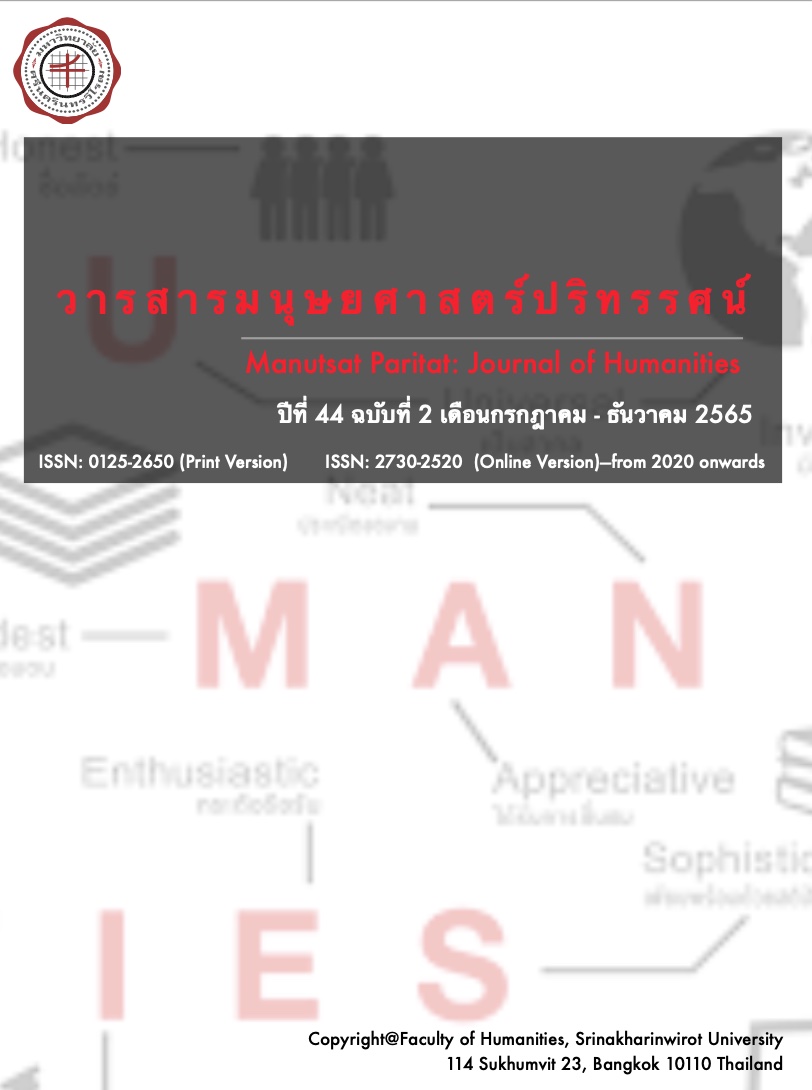The Concept of Patriarchy in South Korean Movies and TV Shows
Main Article Content
Abstract
The purpose of this research was to analyze the concept of patriarchy in South Korean movies and TV shows. The data were gathered from the two South Korean movies and the five TV shows. The two movies were Kim Ji young: Born 1982 and Samjin Company English Class. The five TV shows included Hymn of Death (2 episodes), 18 Again (16 episodes), SKY Castle (20 episodes), Strong Woman Do Bongsoon (16 episodes), and MY ID is Gangnam Beauty (16 episodes). They were aired through Netflix and Viu platforms. The findings revealed the reflection of patriarchy through gender discrimination, which could be found more frequently at 57.70 %, followed by gender stereotypes at 23.07 %. Exercising the patriarch’s power was found the least at 19.23 %. The findings reflect violent behaviors in contemporary South Korean society which could be a negative effect of the belief and value in patriarchy.
Article Details

This work is licensed under a Creative Commons Attribution-NonCommercial-NoDerivatives 4.0 International License.
Any unauthorized copying, publication, reproduction or distribution of copyrighted works appeared in Manutsat Paritat: Journal of Humanities is an infringement of the copyright owners’ rights. To authorize the copying, publication, reproduction or distribution of copyrighted works to be appeared in other printed materials or any online media, please write to MPJHthaijo@gmail.com for permission.
References
จักรกริช สังขมณี. (2560). แนะนำหนังสือ ความเป็นชาย(ส์)หลอกมิติ: การสร้างความรู้ การถือครองอำนาจ และการกลายเป็นอื่น Masculinities. วารสารสังคมศาสตร์, 23, 9.
ปฏิญญาสากลว่าด้วยสิทธิมนุษยชน. (10 ธันวาคม 2491). ปฏิญญาสากล. https://humanrights.mfa.go.th/upload/pdf/udhr-th-en.pdf
รัญชนีย์ ศรีสมาน ใกล้รุ่ง ภูอ่อนโสม. (2563). อำนาจของผู้หญิง : การท้าทายคความสัมพันธ์เชิงอำนาจกับแนวคิดปิตาธิปไตยในนวนิยายสมัยใหม่. วารสารมนุษย์กับสังคม คณะมนุษยศาสตร์และสังคมศาสตร์, 43-61.
สรยา รอดเพชร, ทัศนีย์ ทานตวาณิช และนัทธนัย ประสานนาม. (2561). ผู้หญิงกับปิตาธิปไตยในนวนิยายของอุทิศ เหมะมูล. Journal of Humanities and Social Sciences, 14(1), 53–80. เข้าถึงได้จาก https://so03.tci thaijo.org/index.php/eJHUSO/article/view/131587
เสนาะ เจริญพร. (2546). ภาพเสนอผู้หญิงในวรรณกรรมไทยช่วงทศวรรษ 2530 : วิเคราะห์ความโยงใยกับประเด็นทางสังคม. เชียงใหม่: บัณฑิตวิทยาลัย มหาวิทยาลัยเชียงใหม่, 2546.
อนุสัญญาต่อต้านการเลือกปฏิบัติทางการศึกษา. (10 ธันวาคม 2503). สนธิสัญญาพหุภาคี. https://adsdatabase.ohchr.org/IssueLibrary/UNESCO%20Convention%20against%20Discrimination%20in%20Education.pdf
He, X. H และมาโนช ดินลานสกูล. (2564). สังคมปิตาธิปไตย : ภาพสะท้อนบุรุษมีอำนาจและสิทธิเหนือสตรี จากนวนิยาย “ข้างหลังภาพ” ของศรีบูรพา. การประชุมหาดใหญ่วิชาการระดับชาติและนานาชาติครั้งที่ 12 พ.ศ. 2564 (หน้า 273-285). หาดใหญ่: มหาวิทยาลัยหาดใหญ่.
Barfield, T. (2010). Afghanistan: A cultural and political history. Princeton: Princeton University Press.
Bélanger, D. (2002). Son preference in a rural village in North Vietnam. Studies in Family Planning, 33(4): 321-334. Retrieved from https://www.academia.edu/13325531/Son_Preference_in_
a_Rural_Village_in_North_Vietnam
Bhasin, K. (2004). What is patriarchy. New Delhi: Women Unlimited.
Casico, W. (1995). Managing human resource, productivity, quality of work life, profits (4th edition). New York: McGraw Hill Internationals.
Casad, B. J., & Wexler, B.R. (2017). The SAGE encyclopedia of psychology and gender. Thousand Oaks, SAGE Publications, Inc.
Charrad, M. M. (2001). States and women's rights: The making of postcolonial Tunisia, Algeria, and Morocco. Berkeley: University of California Press.
Connell, R. W. (2005). Masculinities. Berkeley: University of California Press.
Freud, S., Strachey, J., & Richards, A. (1977). On sexuality : Three essays on the theory of sexuality and other works. New York: Penguin Books.
Hudson, V., & Den Boer, A. (2017). Patrilineality, son preference, and sex selection in South Korea and Vietnam. Population and Development Review, 43(1), 119-147. Retrieved from https://onlinelibrary.wiley.com/doi/epdf/10.1111/padr.12041
Jain, D. (2005). Woman, development, and the UN: A sixty-year quest for equality and justice. Indianapolis: Indiana University Press.
KIHASA. (1992). Population and family planning in Korea - papers for the Korea program of the 23rd EWPI summer seminar on population. Korea Institute for Health and Social Affairs.
Kim, H. W., & Cook, P. J. (2011). The continuing importance of children in relieving elder poverty: Evidence from Korea. Aging and Society, 31(06), 953-976.
King, E. M., & Mason, A. D. (2001). Engendering development through gender equality in rights, resources, and voice. New York: Oxford University Press.
Lerner, G. (1989). The creation of patriarchy. New York: Oxford University Press.
Linda, Z. (2014). Factors causing gender inequality in education in Tanzania: A Case of korogwe district secondary schools [Master’s thesis, The Open University of Tanzania]. University of Tanzania. Retrieved July 02, 2019 from http://repository.out.ac.tz/826/1/ZACHARIA_LINDA__-_DISSERTATION_FINAL.pdf
Lundberg, S., Pabilonia, S. W., & Ward–Batts, J. (2007). Time allocation of parents and investments in sons and daughters. University of Washington. Retrieved from http://citeseerx.ist.psu.edu/viewdoc/download doi=10.1.1.619.753&rep=rep1&type=pdf
Murdock, G. P. (1949). Social structure. New York: The Macmillan Press.
Nadal, K. (2017). The SAGE encyclopedia of psychology and gender. Thousand Oaks: SAGE Publications, Inc.
Organisation for Economic Co-operation and Development. (2008). OECD employment outlook 2008. Paris. OECD. Retrieved from https://read.oecd ilibrary.org/employment/oecd-employment-outlook-
_empl_outlook-2008-en#page1
Organisation for Economic Co-operation and Development (2012). gender equality in education, employment and entrepreneurship: Final report to the MCM 2012 c/min (2012)5, Paris. OECD. Retrieved from
https://www.oecd.org/employment/50423364.pdf
Park, J. B. (2001). Patriarchy in Korean society: Substance and appearance of power. The Academy of Korean Studies Korea Journal, 41(4). 48-73. Retrieved from https://www.koreasociety.org/images/pdf/KoreanStudies/Monographs_GeneralReading/GettingtoKnowKorea/GTKK%206%20Boo%20Jin%20Park%20Patriarchy%20In%20Korean%20Society.pdf
Park, L. (2019, March 7). IBM study reveals advancing women is still not a priority for 79 percent of global organizations. Retrieved from https://newsroom.ibm.com/2019-03-07-IBM-Study-Reveals-Advancing-Women-is-Still-Not-a-Priority-for-79-percent-of-Global-Organizations
Westley, S. B., & Choe, M. K.. (2007). How does son preferences affect populations in Asia?. Asia Pacific Issues, (84), 1-12. Retrieved from https://www.eastwestcenter.org/system/tdf/private/api084.pdf?file=1&type=node&id=32202
Statistics Korea. (2005). 2005 statistics on the age, Retrieved from www.kostat.go.kr
Sultana, A. (2010, July). Patriarchy and women’s subordination: A theoretical analysis. The Arts Faculty Journal, (04), 1-18.
UNESCO. (1997). World Education Report 1995 (3rd edition). Oxford: Oxford University Press
Walby, S. (1991). Theorizing patriarchy. Oxford, UK & Cambridge, USA: Blackwell Publishers Ltd.
김영주. (2002). 텔레비전 드라마가 기혼 직장 여성에 대한 성 역할 태도에 미치는 영향 -일일 드라마 <우리가 남인가요>를 중심으로 [석사학위논문 한양대학교 대학원]. KERIS. http://www.riss.kr/link?id=T8309334
김정기.(1999). 텔레비전 시청과 친 사회적 태도의 상관관계-텔레비전의 긍정적 효과에 대한 탐사적 연구.
한국 언론학보, 1999(13호). 155-188.
유지연. (1999). 남아선호경향과 심리적 부담감에 관한 연구 -기혼남녀를 중심으로
[석사학위논문 이화여자대학교 대학원]. KERIS. http://www.riss.kr/link?id=T7508076.
여승훈. (2010). 중등학교 혼성학급 체육수업시 성차별요인에 관한 [석사학위논문 동아대학교 대학원]. KERIS. http://www.riss.kr/link?id=T12439379.
이정희. (1998). 남아선호에 대한 지배담론과 저항에 관한 연구 - 기혼여성의 출산행위를중심으로 [석사학위논문 이화여자대학교 대학원]. KERIS. http://www.riss.kr/link?id=T7110674.
최신덕, & 이숙인. (2017). 삼종지도 (三從之道). Encyclopedia of Korean Culture.
한국민족문화대백과사전. Retrieved from http://encykorea.aks.ac.kr/Contents/Item/E0026813


